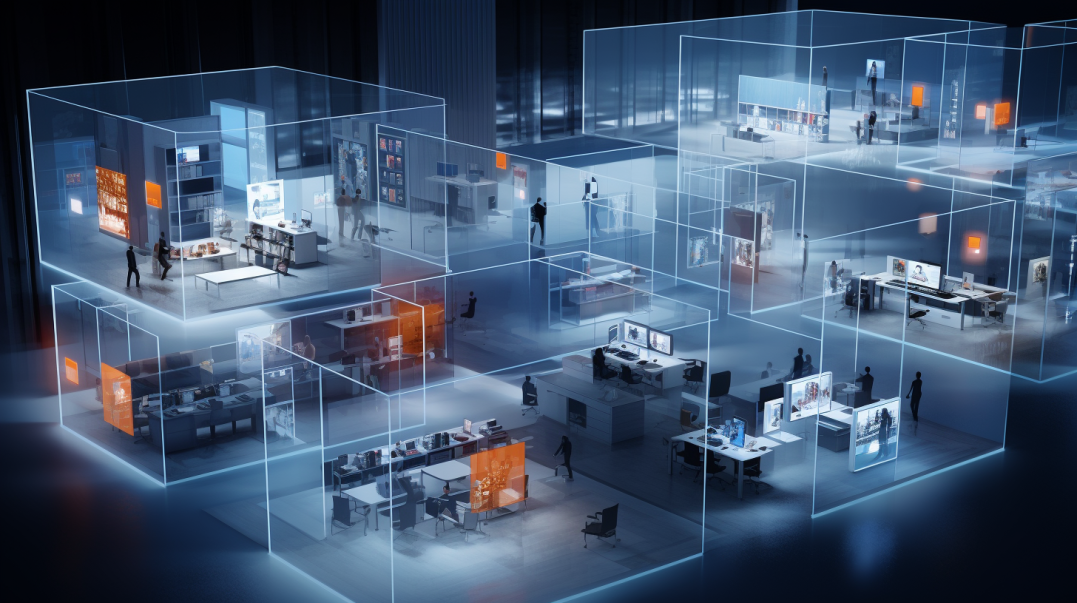The concept of the Internet of Things (IoT) revolves around the integration of physical objects equipped with sensors and actuators that establish communication with computing systems through wired or wireless networks. This interaction enables the digital monitoring and potential control of the physical environment.
Wondering if your residence boasts a smart thermostat or if you’re adorned with a fitness tracker to enhance your physical activity? If so, you’re seamlessly integrated into the vast realm of the IoT devices and web apps. Its influence has not only permeated our daily lives but has also left an indelible mark on organizational processes.
IoT harnesses diverse technologies to bridge the gap between the digital and physical realms. Objects in the physical realm are fitted with sensors, capable of monitoring variables such as temperature, motion, or any environmental changes. Accompanying these are actuators, responding to signals from sensors by initiating specific actions. Wired networks, like Ethernet, or wireless networks, such as WiFi and cellular, facilitate communication between sensors, actuators, and computing systems. This interconnected ecosystem oversees the health and activities of connected objects and machinery.
In the consumer IoT landscape, where IoT expertise is paramount, we navigate the intricate IoT Development Process. This involves oT platform building, meticulous IoT Architecture design, and the integration of cutting-edge IoT sensors. Whether it’s an individual IoT device or intricate IoT data patterns, our focus is on delivering top-notch solutions for IoT-generated data analytics.
Remarkably, the scope of monitored physical objects is not confined to manufactured entities but extends to elements in nature, people, and animals. While some organizations may adopt a broader perspective on IoT, our definition excludes systems solely relying on embedded sensors for intentional human input, like smartphone apps with touchscreen interfaces or networked computer software utilizing standard keyboards and mice.
The perpetual connectivity facilitated by IoT, coupled with data and analytics, opens up new avenues for companies to innovate products and services while enhancing operational efficiency. Undoubtedly, IoT has emerged as a pivotal force in the digital transformation of business and the economy, making it one of the most significant trends since the 2010s.
What are some IoT applications?
What are some instances of IoT applications? Exploring these applications, often referred to as use cases, provides a practical understanding of the scope of IoT. Generally, IoT applications manifest in one of nine domains.
- Human Health: Devices can be affixed to or implanted within the human body, including wearables or ingestible devices that monitor health, manage diseases like diabetes, and promote overall wellness.
- Home: Homeowners can integrate devices such as home voice assistants, automated vacuums, or security systems.
- Retail Environments: IoT devices in stores, banks, restaurants, and arenas facilitate self-checkout, extend in-store offers, and optimize inventory.
- Offices: IoT applications in offices may involve energy management or building security.
- Standardized Production Environments: In settings like manufacturing plants, hospitals, or farms, IoT applications strive for operational efficiency and optimization of equipment use and inventory.
- Custom Production Environments: In specialized contexts like mining, construction, or oil and gas exploration, IoT solutions may be employed for predictive maintenance or health and safety efforts.
- Vehicles: IoT aids in condition-based maintenance, usage-based design, and presales analytics for various modes of transportation, including cars, trucks, ships, airplanes, and trains.
- Cities: IoT expertise contributes to adaptive traffic control, smart meters, environmental monitoring, and resource management within urban areas.
- Outdoor Environments: In urban or outdoor settings such as railroad tracks, autonomous vehicles, or flight navigation, IoT applications encompass real-time routing, connected navigation, and shipment tracking.
Beyond these, real-world examples abound. IoT solutions are deployed in diverse scenarios, from optimizing food-compliance processes in refrigerators for restaurants to tracking livestock in fields and monitoring meeting room usage in offices, illustrating the expansive utility of IoT across various domains.
What is the economic impact of IoT?
What economic implications does IoT have? The potential value of an IoT software development company is substantial and continually expanding of IoT solutions. By 2030, projections suggest it could reach up to $12.5 trillion globally, encompassing the value realized by consumers and customers utilizing IoT products and services.
This economic potential varies across different contexts and applications, with factory settings and applications in human health emerging as significant contributors. Factory settings alone could yield between $1.4 trillion and $3.3 trillion by 2030, representing slightly over a quarter of the total potential value. In the realm of human health, the IoT’s economic impact could account for approximately 14 percent of the overall estimated value.
Examining IoT’s value through the lens of use-case clusters, where similar applications are adapted to different settings, reveals key contributors to its economic potential. Some prevalent use cases play a substantial role in shaping IoT’s economic impact:
- Operations Optimization: Enhancing the day-to-day management of assets and personnel for increased efficiency constitutes a significant portion, contributing to 41 percent of IoT’s potential economic value.
- Health: Health-related applications hold a notable share, comprising 15 percent of the estimated total value.
- Human Productivity: Improving human productivity stands at 15 percent of IoT’s economic potential.
- Condition-Based Maintenance: Devoting attention to maintenance based on real-time conditions contributes 12 percent to the overall economic value.
Additionally, there are other noteworthy clusters such as sales enablement, energy management, autonomous vehicles (emerging as the fastest-growing cluster), and safety and security. The diverse landscape of IoT applications showcases its immense potential across various sectors, promising significant economic benefits in the coming years.
What are IoT platforms?
To derive value from IoT divides and apps, having a platform for creating and managing applications, running analytics, and securing data is crucial. Essentially, these platforms operate in the background, streamlining processes for developers, managers, and users—similar to the role of an operating system for a laptop. They address challenges such as connecting to and extracting data from diverse endpoints, even in inconvenient locations with intermittent connectivity.
When selecting an IoT platform, a solid understanding of your company’s IoT strategy is essential. Here are five key characteristics to consider during the evaluation of IoT platforms:
- Applications Environment: Assess whether the platform can develop, test, and maintain multiple applications. Additionally, evaluate its ability to seamlessly connect with existing applications used by your company, such as those for enterprise resource planning.
- Data Management: Examine the platform’s capability to structure and integrate diverse and unfamiliar data sets.
- Ownership of Cloud Infrastructure: Investigate whether the infrastructure provider owns and operates its own data centers or which public cloud provider it utilizes. (For more insights, refer to “What is cloud computing?”)
- Security: Scrutinize the platform’s commercial-grade authentication, encryption, and monitoring capabilities, and identify any distinctive features in this regard.
- Edge Processing and Control: Evaluate whether the platform can perform edge analytics without necessitating the transfer of data to the cloud first. Additionally, assess its configurability for controlling local assets without human intervention.
What should be considered regarding IoT security?
The proliferation of IoT devices has introduced new vulnerabilities for companies, given the interconnected nature of these devices. As the number of connected “things” increases, so does the potential attack surface. In the pre-IoT era, a large corporate network might have had to secure 50,000 to 500,000 endpoints. In contrast, IoT networks may involve millions or even tens of millions of endpoints, emphasizing the need for robust cybersecurity measures.
Addressing customer privacy concerns related to connected devices is crucial, but managing IoT cybersecurity goes beyond that—it involves safeguarding critical equipment such as pacemakers or entire manufacturing plants. An attack on such systems could jeopardize customer health or disrupt a company’s production capabilities.
For CEOs and leaders dealing with IoT cybersecurity, the following six recommendations or actions are essential:
- Understand the Impact on Your Industry: Gain a comprehensive understanding of what IoT security entails for your specific industry and business model.
- Define Clear Roles and Responsibilities: Establish explicit roles and responsibilities for IoT security within your supply chain.
- Engage with Regulators: Initiate strategic conversations with regulators and collaborate with other industry stakeholders to stay abreast of evolving cybersecurity standards and regulations.
- Prioritize Cybersecurity Across the Product Life Cycle: Treat cybersecurity as a priority throughout the entire product life cycle, developing the necessary skills and practices to uphold it.
- Cultivate a Cybersecurity Mindset: Foster a culture that values cybersecurity by transforming mindsets and rigorously developing the requisite skills within your organization.
- Establish Communication Channels: Create a point-of-contact system for external security researchers and implement a post-breach response plan to effectively address and mitigate security incidents.
What is IIoT?
The Industrial Internet of Things, abbreviated as IIoT, represents a subset of advanced manufacturing technologies collectively known as Industry 4.0, synonymous with the Fourth Industrial Revolution.
What advantages does IIoT offer? It holds the potential to significantly minimize downtime, introduce innovative business models, enhance customer experiences, and fortify organizational resilience. In the era of COVID-19, for instance, companies leveraging digital management tools and continuous connectivity demonstrated the ability to swiftly adapt to market changes. They achieved this by promptly adjusting production capacity and supporting remote operations simultaneously.
For companies embracing IIoT in their manufacturing digital transformation, seven guideposts can be followed to align business, organization, and technology spheres. This approach aids leaders in strategically positioning their organizations to fully harness the benefits of IIoT:
Business:
- Identify and prioritize use cases.
- Focus on plant rollout and enablement.
Organization:
- Keep a vigilant eye on change and performance management.
- Build capabilities and embrace new ways of working.
Technology:
- Attend to IIoT and data infrastructure, with a particular emphasis on core platform design, including IT/OT (information technology/operational technology) cybersecurity.
- Choose an IIoT platform, considering the imperative role of the cloud in manufacturing.
- Monitor the technology ecosystem.
What do I need to know about Internet of Things B2B uses?
B2B solutions within the Internet of Things constitute the predominant source of economic value generated from IoT development services to date. In B2B scenarios, the integration of IoT and AI holds the potential to enhance the predictive maintenance capabilities of machines. Simultaneously, it empowers service providers to monitor the real-time health of their assets, allowing for proactive intervention to address issues before significant breakdowns occur.
While B2C applications, particularly in the realm of home-automation solutions, have experienced unexpectedly rapid growth, B2B applications are anticipated to maintain a substantial share of the total IoT value through 2030, projected to account for 62 to 65 percent.
What factors may influence the adoption of IoT?
Achieving greater value from IoT development services involves navigating both favorable and challenging dynamics that impact its adoption.
Three key factors could propel the adoption and impact of IoT solutions:
- Perceived Value Proposition: Customers recognize the value in IoT, appreciating its role in facilitating digital transformation and sustainability efforts, exemplified by the $1.6 trillion in economic value generated from IoT solutions in 2020.
- Technology: Affordable technology, facilitating widespread IoT deployments, is available for a majority of IoT applications. Progress in hardware aligns with advancements in analytics, AI, and machine learning, enabling more detailed insights and expedited decision-making processes.
- Networks: The backbone of IoT, higher-performing 4G and 5G networks are becoming increasingly accessible to a larger population.
Conversely, several factors could impede adoption, including the necessity for change management (achieving scale requires collaborative efforts to instill new behaviors), interoperability challenges, installation difficulties, and concerns regarding cybersecurity and individual privacy.
For organizations in the initial stages of their IoT journey, considerations about what could expedite enterprise IoT adoption are valuable. Insights from Wienke Giezeman, a serial tech entrepreneur and initiator of The Things Network, emphasize the importance of creativity and simplicity over reliance on financial resources: “We’ve seen this in the industry again and again—you cannot solve IoT problems with money. It’s so tempting to try to solve these problems with cash, but really, it’s the creativity and pushing for simplicity that leads to the solution, which shouldn’t be so complicated.”
Is there merit in expanding IoT initiatives?
To truly unlock the advantages of IoT solutions, companies need to adopt the technology on a large scale rather than pursuing isolated endeavors. If your organization is venturing into IoT adoption, consider these seven impactful actions for scaling IoT pros:
- Establish Ownership: Clearly define the individual or team responsible for overseeing IoT within the organization.
- Design for Scalability: Incorporate scalability considerations into the design from the outset.
- Embrace Comprehensive Deployment: Instead of tentative approaches, deploying multiple use cases can act as a catalyst for transforming operating models, workflows, and processes.
- Invest in Technical Talent: Allocate resources to cultivate a skilled technical workforce capable of navigating and maximizing IoT capabilities.
- Organizational Transformation: Extend the focus of IoT integration beyond the IT function to encompass the entire organization.
- Prioritize Interoperability: Advocate for interoperability to ensure seamless communication and integration across diverse IoT components.
- Proactive Ecosystem Building: Take a proactive stance in shaping the environment by constructing and managing IoT ecosystems.
IoT Software Development Services You May Need
IoT software development services have emerged as a cornerstone for businesses aiming to capitalize on the transformative potential of the Internet of Things. These services encompass a comprehensive suite of solutions, ranging from IoT development to the creation of web applications tailored to seamlessly integrate with IoT devices. A reputable IoT software development company takes a holistic approach, offering end-to-end services that cover the entire IoT development process. This includes expertise in IoT architecture, the intricacies of IoT sensors, and the development of IoT devices and web apps.
The prowess of such services extends to IoT data analytics, enabling businesses to derive meaningful insights from the vast amounts of data generated by IoT devices. Additionally, these services cater to diverse sectors, addressing specific needs such as consumer IoT applications and IoT projects across various industries. As businesses increasingly recognize the significance of IoT in optimizing operations, enhancing productivity, and unlocking new avenues for growth, IoT software development services have become indispensable in translating these aspirations into tangible, innovative solutions.
Here’s a list of popular IoT software development services:
- End-to-End Solutions: Offering comprehensive services covering the entire IoT development lifecycle.
- IoT Development Expertise: Specialized knowledge and skills in IoT development, ensuring efficient and effective implementation.
- Web Application Development: Crafting web applications seamlessly integrated with IoT devices for a cohesive user experience.
- IoT Architecture: Designing robust and scalable IoT architectures to support diverse applications and use cases.
- Sensor Integration: Expertise in integrating a variety of IoT sensors, enabling data collection and transmission.
- Device Development: Building innovative IoT devices with a focus on functionality, connectivity, and user experience.
- Data Analytics: Proficiency in IoT data analytics to derive actionable insights from the vast volumes of generated data.
- Industry-Specific Solutions: Tailoring services to meet the unique requirements of various industries, such as healthcare, manufacturing, and energy.
- Consumer IoT Applications: Developing applications that enhance the consumer experience and leverage IoT-generated value.
- Project Consulting: Providing strategic guidance and consultation throughout the IoT project lifecycle.
- Platform Building: Creating robust IoT platforms to facilitate seamless communication and interaction between devices.
- Use-Case Clusters: Addressing diverse use-case clusters, including operations optimization, health applications, and human productivity enhancements.
- IoT Expertise Sharing: Sharing insights on IoT expertise, keeping clients informed about the latest developments and best practices.
- Security Measures: Implementing robust security measures to safeguard IoT ecosystems against potential threats.
- Innovation Focus: Emphasizing innovation to stay at the forefront of IoT technology advancements.
These aspects collectively contribute to the popularity and effectiveness of IoT software development services, making them essential for businesses navigating the IoT landscape.
IoT Consulting Services
Engaging in IoT consulting services is a strategic move for businesses seeking to navigate the complex landscape of IoT solutions. A proficient IoT consulting firm plays a pivotal role in guiding clients through the intricacies of IoT development, ensuring a seamless process from concept to implementation. With a focus on IoT expertise, these consulting services provide valuable insights into the IoT development process, including the architecture, sensors, and devices crucial for successful integration. The role extends beyond mere technical aspects, encompassing a thorough understanding of IoT data patterns and analytics. As a trusted IoT software development company, such consultants offer tailored advice on IoT projects, application development, and platform building. Through their consumer IoT insights, businesses can tap into the vast potential of IoT-generated value, capitalizing on opportunities within use-case clusters such as operations optimization, health applications, and human productivity. In essence, IoT consulting is an indispensable partner for enterprises navigating the dynamic realm of IoT, ensuring they harness the full economic impact of this transformative technology.
Finals
In conclusion, eJaw stands out as a leading IoT software development company with a comprehensive suite of IoT development services. Specializing in the creation of cutting-edge IoT devices and web apps, eJaw exhibits unparalleled expertise in IoT application development and consumer IoT solutions. With a dedicated focus on IoT projects, the company excels in providing IoT consulting and navigating the intricate IoT development process. eJaw’s proficiency extends to IoT platform building, crafting robust IoT architectures, and implementing advanced IoT sensors to harness IoT-generated data patterns. As a trailblazer in the realm of IoT software development, eJaw remains committed to delivering innovative solutions that redefine the landscape of IoT devices and solutions, ensuring clients embark on a transformative journey fueled by technology and strategic insights.










